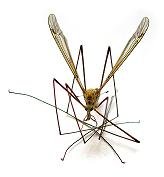Advertisment
A reservoir of mosquito disease!

A large scale, five year study of mosquitoes from different ecological regions in Kenya, including savannah grassland, semi-arid Acacia thorn bushes, and mangrove swamps, found a reservoir of viruses carried by mosquitoes (arboviruses) that are responsible for human and animal diseases.
Over 450,000 mosquitoes from 11 sites across Kenya were screened by researchers from the United States Army Medical Research Unit,- Kenya (part of the Walter Reed Army Institute of Research), Kenya Medical Research Institute, and the International Centre for Insect Physiology and Ecology in Nairobi. 83 different viruses were identified, including alphaviruses, flaviviruses and orthobunyaviruses.
Mosquitoes were infected with West Nile, Ndumu, Sindbis, Bunyamwera, Pongola and Usutu virus at many test sites which represented diverse ecological locations. These viruses pose a significant public health problem especially in East Africa. West Nile virus has been a source of concern, not only in East Africa but around the world with outbreaks recently in the US and across Europe. Ngari virus, which was associated with hemorrhagic fever in northern Kenya in the late 1990s was isolated from two sites in Kenya
Previously unknown viruses were also found: one with similarities to the newly discovered Chaoyang virus in China, and two more related to Quang Binh virus.
From the location of infected mosquitoes it seems that livestock as well as mosquitoes could be a reservoir of disease. Caroline Ochieng who led the study explained, “The importance of mosquitoes in the spread of arboviral diseases in East Africa cannot be over-emphasized. They have caused outbreaks afflicting both human and livestock with devastating public health and economic consequences. Implementation of mosquito and arbovirus surveillance is therefore vital as part of an early warning system and rapid response plan.”
Commenting on the potential impact of this study Linfa Wang, Editor-in-Chief of Virology Journal said, “This important study highlights the need for on-going surveillance in animals and insect vectors, in order to prepare for potential virus outbreaks in humans.”
This research, published in BioMed Central’s open access journal Virology Journal, highlights the need for continued surveillance in order to monitor the risk of disease outbreaks.
For further information E-mail: ruth.francis@biomedcentral.com
Ful article available here http://www.virologyj.com/imedia/8019174788712169_article.pdf?random=936629





